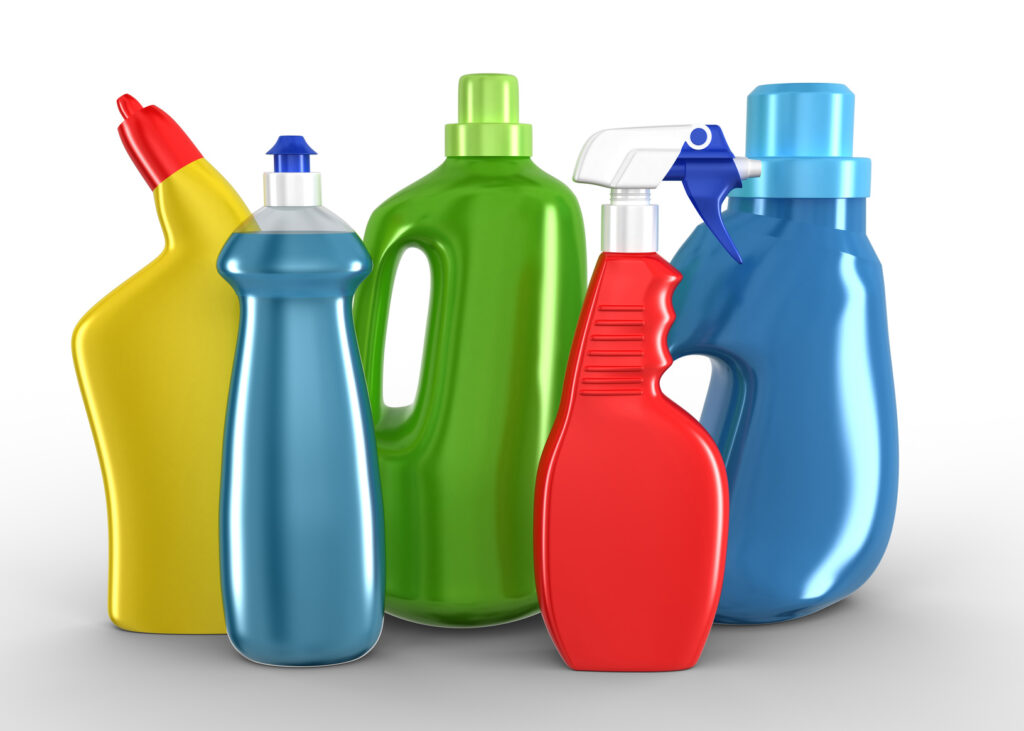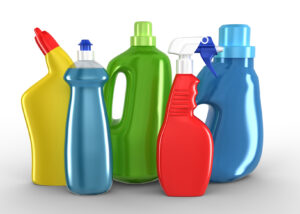Cleaning products
In addition to body cleansing and laundry, cleaning the home and household is one of the basic needs of modern society. Regular cleaning is also a crucial prerequisite for hygiene and thus for health care. But beware – all chemicals we use for washing and cleaning do not disappear, but can find their way back to us via the environment.
Some of the ingredients used in detergents and cleaning products can be a heavy burden on the water bodies and trigger (skin) allergies in consumers. Particularly problematic are highly corrosive drain and pipe cleaners as well as products with active chlorine such as sanitary cleaners, bleaches and disinfectants (eg Eau de Javel). Concentrated acids and alkalis damage the water and can have a direct impact on the flora and fauna of water bodies by changing the pH value. Even the presence of sewage treatment plants does not solve this problem.
In view of the various and sometimes sensitive materials used in the household today, especially in the kitchen, bathroom and toilet, care has a much higher priority than in the past. The selection of cleaning agents and detergents in supermarkets and specialist shops is therefore very large. A distinction is made between all-purpose cleaners, dishwashing detergents, toilet cleaners, lime and glass cleaners, lubricating soaps and many other products. Special products are often not really necessary. Often general-purpose or neutral cleaners, lime cleaners, dishwashing detergents, alcohol cleaners and abrasive powders are completely sufficient. The targeted use of high-quality microfibre cloths can significantly reduce the use of chemicals.
As part of the „Shop Green“ campaign of the SuperDrecksKëscht®, environmentally friendly detergents and cleaning products are highlighted with the “Shop Green” logo in participating retailers. The products recommended by SDK must meet strict criteria regarding ingredients such as surfactants, bleaching agents, builders, solvents, fragrances and additives, etc., as well as containers (e.g. use of recycled plastic). The selected criteria make it possible to minimise the impact of cleaning on the environment, especially water bodies, and the health of consumers.
- Avoid using special cleaners wherever possible and use microfibre cloths, brushes, suction cups and other mechanical instruments instead. This means no water use and less water pollution.
- Otherwise, use cleaning agents sparingly and properly and follow the dosing instructions.
- Never mix several products. This can lead to undesirable chemical reactions.
- Never fill cleaning products or other chemicals into unlabelled containers.
- Use environmentally friendly products. Products labelled ‘Shop Green’ are tested, among other things, on the influence on water bodies and biodegradability in general.
- Environmentally friendly cleaning agents are also chemicals. Therefore, store the products in such a way that children and pets do not have access to them.
- Car and vehicle washing at home is generally not environmentally friendly. Modern car washes, on the other hand, use little water through recirculation and are strictly controlled with regard to their waste water.


Cleaning products
In addition to body cleansing and laundry, cleaning the home and household is one of the basic needs of modern society. Regular cleaning is also a crucial prerequisite for hygiene and thus for health care. But beware – all chemicals we use for washing and cleaning do not disappear, but can find their way back to us via the environment.
Some of the ingredients used in detergents and cleaning products can be a heavy burden on the water bodies and trigger (skin) allergies in consumers. Particularly problematic are highly corrosive drain and pipe cleaners as well as products with active chlorine such as sanitary cleaners, bleaches and disinfectants (eg Eau de Javel). Concentrated acids and alkalis damage the water and can have a direct impact on the flora and fauna of water bodies by changing the pH value. Even the presence of sewage treatment plants does not solve this problem.
In view of the various and sometimes sensitive materials used in the household today, especially in the kitchen, bathroom and toilet, care has a much higher priority than in the past. The selection of cleaning agents and detergents in supermarkets and specialist shops is therefore very large. A distinction is made between all-purpose cleaners, dishwashing detergents, toilet cleaners, lime and glass cleaners, lubricating soaps and many other products. Special products are often not really necessary. Often general-purpose or neutral cleaners, lime cleaners, dishwashing detergents, alcohol cleaners and abrasive powders are completely sufficient. The targeted use of high-quality microfibre cloths can significantly reduce the use of chemicals.
As part of the „Shop Green“ campaign of the SuperDrecksKëscht®, environmentally friendly detergents and cleaning products are highlighted with the “Shop Green” logo in participating retailers. The products recommended by SDK must meet strict criteria regarding ingredients such as surfactants, bleaching agents, builders, solvents, fragrances and additives, etc., as well as containers (e.g. use of recycled plastic). The selected criteria make it possible to minimise the impact of cleaning on the environment, especially water bodies, and the health of consumers.
- Avoid using special cleaners wherever possible and use microfibre cloths, brushes, suction cups and other mechanical instruments instead. This means no water use and less water pollution.
- Otherwise, use cleaning agents sparingly and properly and follow the dosing instructions.
- Never mix several products. This can lead to undesirable chemical reactions.
- Never fill cleaning products or other chemicals into unlabelled containers.
- Use environmentally friendly products. Products labelled ‘Shop Green’ are tested, among other things, on the influence on water bodies and biodegradability in general.
- Environmentally friendly cleaning agents are also chemicals. Therefore, store the products in such a way that children and pets do not have access to them.
- Car and vehicle washing at home is generally not environmentally friendly. Modern car washes, on the other hand, use little water through recirculation and are strictly controlled with regard to their waste water.








